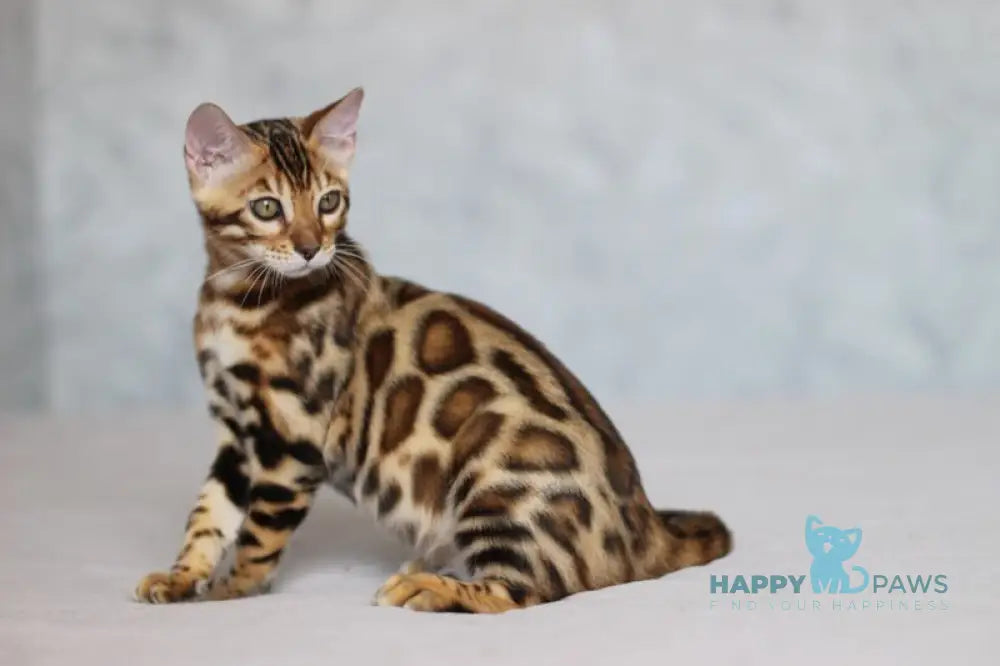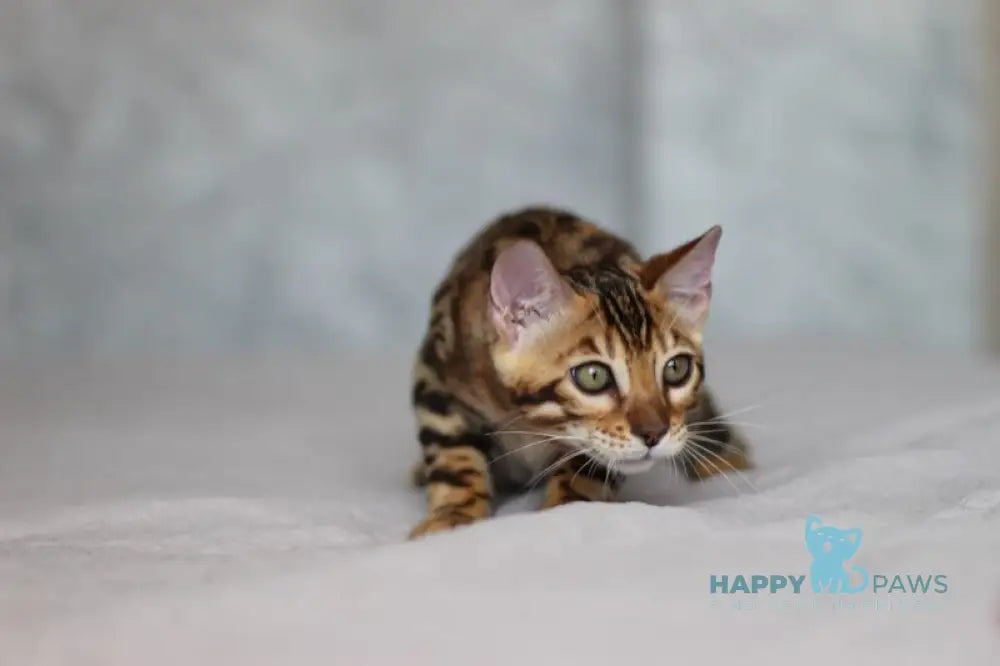Collections
-
- Abyssinian
- Balinese
- Bambino
- Bengal
- British Shorthair
- British Longhair
- Burmese
- Cornish Rex
- Chausie
- Devon Rex
- Egyptian Mau
- Elf
- Exotic
- Kurilian Bobtail
- Lykoi
- Maine Coon
- Munchkin
- Oriental Shorthair
- Persian
- Ragdoll
- Russian Blue
- Savannah
- Scottish Fold
- Scottish Straight
- Selkirk Rex
- Siamese
- Siberian
- Somali
- Sphynx
- Toyger

Bengal
36 products
Showing 1 - 24 of 36 products
How to Know if a Bengal Cat Is Right for You
Have you ever imagined what your living room might be like if you had a tiny leopard skulking around? In a nutshell, that is essentially the Bengal cat. When a cat enthusiast Jean Mill mixed an Asian leopard cat with a domestic one in the 1960s, the breed took off. Her objective? To combine the adorable charm of a home cat with that wild, exotic cat breeds. Although breeding them wasn't easy and required a great deal of patience, the outcome was stunning. Bengals are a popular breed of cat these days, appealing to anybody who likes a little flair in their feline companions.
When the Wild Meets the Domestic in Bengal Cats
Historically, after inbreeding Prionailurus bengalensis (Asian leopard cat), a small wild cat found in distinct parts of Asia, with domestic cats, the Bengal cat was created. The goal was to produce a domestic cat that retains the wild, exquisite markings of the leopard cat. Jean Mill is frequently credited with establishing the present-day Bengal. According to some sources, the breed was established in the 1980s on account of a commitment of breeders.
You're hooked after just one look at a Bengal. Their short, silky coat, which seems to have a marbled look in ways that reflects “wild cat.” This quality is also associated with calm silvers, creamy ivories, or deep gold with leopard-like edges. Their eyes? Green, gold, or even blue piercing set against a muscular, action-ready body. These active house cats are more than simply lovely faces, though; they have a captivating beauty to their movements.
Examining the Physique of Bengal Cats
Bengal cats have short, sleek fur with a little shine. Their coats can be in a variety of patterns, but the most frequent are marbled or spotted. Because of the rosette, related exotic cat breeds appear wild, with spots similar to those found on leopards and jaguars. What’s more, these cats have a color palette, spanning from brown and silver to snow.
Why Bengal Cats Never Sit Still
These wild-looking cats have a lively, curious attitude that sets them apart from regular pocket cats. Bengals require space to climb, jump, and explore; they are nosy and will push their noses into anything. Have a high shelf? They'll manage to climb. They also exhibit intellect, as evidenced by how quickly they can learn new skills.
One peculiar quality? Water is a source of ire for certain Bengalis. Cats have been known to chase a dripping tap as if it were the biggest event of the year. They differ slightly from your average cat, who would rather die than get wet, because of that aspect that shows through.
Training Tips for Active Bengal Owners
It might be challenging to capture Bengals' attention because they are typically quite active house cats. Food is an excellent technique to get your Bengal to pay attention to you because cats are highly motivated by their instincts and desires. In this regard you realize that using the appropriate incentives to motivate your Bengal during training is crucial.
Avoid calorie-dense snacks with unhealthy ingredients, such as artificial flavorings, which might raise nutritional issues. Instead, opt for a high-protein, healthful treat with no extra calories. Choose products with protein listed as the primary ingredient. Whatever food you choose to use as a reinforcer, make sure it doesn't account for more than 10% of wild-looking cats daily caloric intake. Make good use of your reinforcement chances.
Grooming Needs: Simple Yet Essential
We suggest regular brushing schedules because the breed will benefit from it most. Try to follow this advice, even if Bengals require not that much upkeep in terms of grooming.
As a pet owner you should focus on these particular duties if you want to preserve the overall well being of a new family member. Here are what a responsible owner would do:
-
Bengals require brushing weekly – it maintains the gleam of their fur by spreading natural oils. This way, you remove loose fur, preventing hairballs from appearing.
-
Check out if a cat’s ears have signs of inflammation (redness), or uncommon odor. If you noticed these signs, wipe the ears with a cleaner prescribed by your veterinarian.
-
For dental hygiene maintenance, give a cat specific dental chew playthings, considering a routine teeth-brushing regime. It’s done with toothpaste for felines.
Living Space Rules for Bengals
Bengals prefer temperatures between 70°F and 80°F (21°C and 27°C). Ensure that your home is comfortable and well-ventilated all year around. These cats as well as other breeds derived from wilderness are typically found basking in sunlight. If possible, service your Bengals with the sun’s glimmers so they can feel comfortable and embrace the warmth.
What’s more, these active house cats proactively engage in mingling with humans and other pets. If you move from one place to another or still be at work for long hours, you could adopt two cats to keep them in company. You also should dedicate a particular area with all the belongings, including playthings, a little box, food and drink dishes, and scratching posts.
Socialization and Compatibility with Families and Pets
Bengal are gregarious wild-looking cats who spend time together with their owners. Early socialization bridges cats in the development of self-assured and well-mannered virtues.
The socialisation techniques are:
-
Start building social ties for your kittens, preferably at the age of 2-7 weeks. Introduce them to your human friends, gentle handling, and potential noises that may happen.
-
Reinforce a kitten with praise, treats, and pats, after constructive encounters. In this way, you’ll promote amicable behavior and build trustworthy cat-parent relationships.
-
You should make kitten playtime interactive. When it exists on a regular basis, the kitten starts developing essential social skills, preparing for vital bonding pathways.
To summarize, their appearance that belongs to exotic cat breeds elicits interest in cat enthusiasts; their intellectual capabilities and desire to be seen make them applicable in young, proactive families. Before making a decision, ensure that your home is content with stimulus and everyone is ready to give enough attention to a kitten. This breed requires settings where they could find engagement with their owner and easily go with other pets. Decide for yourself, but objectively, a Bengal cat would be the match if your family is okay living with a hyperactive but also gentle feline, having enough time to spend with them.
















































